Introduction
Beans are the edible seed portion of family fabaceae of leguminous plants including various variety like Vicia, Vigna, Cicer, Lathyrus which are consumed by animals and human to meet ideal nutritional demand like high protein,1 dietary fiber,2 low fat, good source of vitamins and minerals3 and phytochemicals including total phenolics, total flavonoid, tannin, and phytosterol.4 Vicia faba contains a good proportion of nutrients like high protein, dietary fiber, folic acid and vitamins.5 Regular beans consumption may improve glycemic control,6,7 reduce cholesterol level and coronary heart diseases, prevent colon cancer and control diabetes,6-8 slow down the risk of obesity9 and antioxidant and anti-inflammatory effect. Sesame (Sesamum indicum L.) belongs to the family Pedaliaceae, which contains moisture, crude proteins, carbohydrates, crude fiber, and ash10 oil (44–58%), mono and poly unsaturated fatty acid(oleic acid and linoleic acid)11-13 various types of vitamins and minerals,14 two lignans like sesamol, sesamolinol, pinoresinol, sesaminol and phytosterol.15 Sesame seed has a positive influence on the antioxidant level,16 lipid peroxidation,17 plasma cholesterol and triacylglycerol level, blood glucose level and blood pressure.18-20 Hyperlipidemia is one of the most risk factors for cardiovascular diseases (CVD) which is now first leading cause of death in World.21 Prevention and management of this disease is now the first priority of the research field among scientists in the world. Experimental studied showed that Vicia faba and sesame seeds in the diet of rat model improved the condition of hyperlipidemia.6,20 NCEPP (National Cholesterol Education Prevention Programme) recommended 2 g plant sterol in the daily diet reduces the plasma cholesterol by 10% in one month.22 However, to the best of our knowledge, no study has been explored for supplementation of seeds of Vicia faba (SVf) and sesame seeds (SSi) separately or combined in the diet as a therapeutic role against secondary hyperlipidemia in rats. Therefore, the aim of the present study was to evaluate the effect of individual supplementation of SVf and SSi and their composite manner for the studied period of 60 days on plasma lipid biomarkers, atherogenic index, oxidative stress, liver function enzymes, antioxidant enzymes and IL-18 level of secondary hyperlipidemia in rats.
Materials and Methods
Preparation of seed of SVf and SSi Dust
The plant materials for the experiment consist of fresh broad bean (Vicia faba) and Sesame (Sesamum indicum) seeds. The broad beans were harvested at the kitchen garden of the Department of Nutrition, Raja Narendra Lal Khan Women’s college, Midnapore, West Bengal, India. Sesame seeds were purchased from a local fruit market in Midnapore, India. Then Vicia faba were washed well and separated from the seeds. Seeds were dried at 40±1°C in an incubator for 3 days. Then both dried seeds were crushed separately in an electric grinder machine. After that, the fine dust of SVf and SSi were considered for the experimental study.
Selection of Animals and Care (experimental subjects and model)
The present experiment was conducted on 30 male Wistar strain adult pathogen free and healthy albino rats having the weight of 250±15 g (rats were purchased from Saha Enterprise (Laboratory Animal Supplier), 386/2, Nilachal, Birati, Kolkata-700051,CPCSEA registered under Ministry of Environment and Forest, Government of India vide no. 1828/PO/BT/S/15/CPCSEA). Animals were kept in normal laboratory condition for 2 weeks prior to experimentation.The animals were housed with 3 rats/cage in a temperature-controlled room (22±20 ˚C) with 12-12 h dark-light cycles (8.00-20.00 h light, 20.00-8.00 h dark) at a humidity of 50±10%. They were provided with standard food and water ad libitum. Animal care was provided according to the Guiding Principle for the Care and Use of Animals.23 The Institutional Animal Ethical Committee (Registration number: 1905/PO/Re/S/2016/CPCSEA) approved this studyto use only 30 rats.24 ND (Normal diet) rats fed experimental diet according to AIN-93G with minor modification. Induction of dyslipidemia was carried out on HLD, HLD+SVf, HLD+SSi and HLD+SVf+SSi by addition of extra 11g coconut oil, 0.5%cholesterol and 5g sucrose in normal diet. HLD+SVf rats was supplemented SVf10%, HLD+SSi rats fed SSi 10%, and HLD+SVf+SSi rats fed SVf 5% +SSi 5% of total foods. (Table 1). The Strategy of combined supplementation keeping view in mind that SVf contain high amount of protein, low in fat, low in phytosterol and SSi contain high amount of phytosterol and unsaturated fat.
Table 1: Composition of the experimental diet and its nutritional analysis
| Foods(g) | ND(n=6) | HLD(n=6) | HLD +SVf(n=6) | HLD + SSi(n=6) | HLD +SVf+SSi(n=6) |
| Corn Starch(g) | 40 | 40 | 30 | 30 | 30 |
| Casin(g) | 25 | 20 | 20 | 20 | 20 |
| Bengal gram flour(g) | 16 | 15 | 15 | 15 | 15 |
| Milk powder(g) | 10 | – | – | – | – |
| Sucrose(g) | 5 | 10 | 10 | 10 | 10 |
| Coconut Oil(g) | 2 | 13 | 13 | 13 | 13 |
| Mineral Mixture(g) | 1 | 0.5 | 0.5 | 0.5 | 0.5 |
| Cholesterol(g) | – | 0.5 | 0.5 | 0.5 | 0.5 |
| Vitamin Premix(g) | 0.5 | 0.5 | 0.5 | 0.5 | 0.5 |
| Salt(g) | 0.5 | 0.5 | 0.5 | 0.5 | 0.5 |
| SVf(g) | – | – | 10 | – | 5 |
| SSi(g) | – | – | – | 10 | 5 |
| Total | 100 | 100 | 100 | 100 | 100 |
| Energy(kcal) | 382.19 | 426.98 | 425.48 | 451.54 | 438.96 |
| Carbohydrate(g) | 59.44 | 58.26 | 54.99 | 51.5 | 53.24 |
| Protein(g) | 23.98 | 18.11 | 20.69 | 19.85 | 20.27 |
| Fat(g) | 5.39 | 13.5 | 13.64 | 18.46 | 16.05 |
| SFA(g) | 3.48 | 10.73 | 10.76 | 11.43 | 11.09 |
| PUFA(g) | 0.56 | 0.88 | 0.94 | 3.06 | 2.0 |
| MUFA(g) | 0.53 | 1.16 | 1.19 | 3.04 | 2.12 |
| Dietary Fiber(g) | 3.08 | 2.91 | 5.32 | 4.0 | 4.66 |
Reagents and chemicals
Major biochemical parameters like total cholesterol (TC), high-density lipoprotein cholesterol (HDL-C), low-density lipoprotein cholesterol (LDL-C), triglycerides (TG), glutamic oxalic transaminase (GOT), glutamate pyruvate transaminase (GPT) were measured by Semi-autoanalyser, other biochemical parameters like Superoxide Dismutase (SOD),Catalase (CAT) and malondialdehyde (MDA) were measured by absorbance UV-VIS Spectrophotometer.
Preparation of the samples for biochemical studies
This experimental study was continued for 60th days. On the 61st day of the experiment, those animals were sacrificed under anesthesia and blood was collected from the aorta and plasma was collected by centrifuge tube. Liver, kidney tissues were collected for determination of different biochemical parameters.
Estimation of plasma lipid profile
TG, TC, HDL-C, and LDL-C were estimated according to our earlier study25 by semiauto analyzer using the standard kit method and the values are expressed as mg/dL.
Fecal cholesterol analysis
Feces were collected for 7 days before and at the end of 60 days, lyophilized, and then milled into a powder. Total lipids were extracted with chloroform: methanol (2:1 v/v) according to the method of Folch et al.,26
Measurement of antioxidant enzyme profiles
The SOD activity was estimated as described by Pradhan et al.,27and values were expressed as nmol of H2O2 consumption/mg of tissue/min. CAT activity was assayed according to the method of Roy et al.,28 and values were expressed as nmol of H2O2 consumption/mg of tissue/min.
Quantification of MDA level
The level of MDA was determined by the established method of Das et al.29in liver tissue which was measured by spectrophotometer at 535 nm and values are expressed nmol/mg of tissue.
Toxicity profile marker of plasma and liver tissue
Liver tissues were homogenized separately in 0.05 M tris-hydrochloric acid (HCl) buffer solution (pH 7.0) at the tissue concentration of 50 mg/mL. This homogenate was centrifuged separately at 10,000 g at 4 ˚C for 10 min and tissue supernatant was collected. Activities of liver enzymes as GOT, GPT were estimated by the method of Roy et al.,30
Determination of IL 18 level using ELISA
The cells were seeded into 96 well plates with 300 μl plasma, containing 2×106 MPMs/mL. The supernatant was stored at ˗20˚C and the levels of IL-18 measured using a specific rat IL-1831 as per information provided in the kit manual (Invitrogen Bioservices India Pvt. Ltd).
Table 2: Food intake, fluid intake by each rat calculated by average intake from six rats.
| ND | HLD | HLD+SVf | HLD+SSi | HLD+SVf+SSi | |
| Diet and Water | ND+ Water | HLD+ Water | HLD+ SVf | HLD+ SSi | HLD+SVf +SSi |
| Food intake (g/day) | 15.05 | 16.99 | 15.87 | 14.81 | 15.13 |
| Fluid Intake (mL/day) | 25.2 | 26.5 | 24.9 | 25.1 | 25.8 |
| Energy Intake(Kcal/rat/day) | 57.51 | 72.54 | 67.52 | 66.87 | 66.41 |
| Carbohydrate Intake(g/rat/day) | 8.94 | 9.89 | 8.72 | 7.62 | 8.05 |
| Protein Intake(g/rat/day) | 3.60 | 3.07 | 3.28 | 2.93 | 3.06 |
| Fat Intake(g/rat/day) | 0.811 | 2.293 | 2.164 | 2.73 | 2.42 |
| SFA Intake(g/rat/day) | 0.326 | 1.82 | 1.70 | 1.69 | 1.67 |
| PUFA Intake(g/rat/day) | 0.084 | 0.149 | 0.149 | 0.453 | 0.302 |
| MUFA Intake(g/rat/day) | 0.079 | 0.197 | 0.188 | 0.450 | 0.320 |
| Dietary Fiber Intake(g/rat/day) | 0.463 | 0.494 | 0.844 | 0.592 | 0.705 |
ND: Normal Diet; HLD: High Lipid Diet; HLD+SVf: High Lipid Diet + Seed of Vicia faba; HLD+SSi: High Lipid Diet + Sesame seeds; HLD+SVf+SSi: High Lipid Diet + Seed of Vicia faba + Sesame seeds; SFA: Saturated Fatty Acid; PUFA: Polyunsaturated Fatty Acid; MUFA: Monounsaturated Fatty Acid
Histopathological analysis of liver tissue
Liver tissues from the experimental rats were fixed in 10% buffered formalin solution embedded in paraffin wax and 5 µm sections were prepared with a rotary microtome. These thin sections were stained with hematoxylin and eosin (H and E), mounted on glass slides and observed for pathological changes under a binocular microscope according to Mani.32
Data and statistical analysis
Data are expressed as a mean ± standard error (SE; (n= 6). ANOVA followed by Bonferroni t-test to detect intergroup differences multiple two-tail t-test and bars differ from each other significantly (p < 0.05).33 Correlations between quantitative normally distributed parameters were assessed with Pearson’s two-way test. A p-value less than 0.05 was considered significant.
Results and Discussion
From the various literatures on dietary management of dyslipidemia in various animal models followed by only cholesterol supplemented to diet with modified in lipids, carbohydrate and sucrose contents.34-36 A model diet for induction of dyslipidemia in rat model based on the increased energy, cholesterol, fat, saturated fatty acids, PUFA, MUFA, dietary fiber and phytosterol intake was planned. HLD group had increased energy, fat, cholesterol, sucrose by 10.48%, 60.07%, 100%, 50% respectively than the ND group. In the second HLD+SVf group had increase energy, fat, cholesterol, sucrose by 10.06%, 60.48%, 100%, 50% respectively than the ND group. In third HLD+SSi group had increase energy, fat, cholesterol, sucrose by 15.35%, 70.80%, 100%, 50% respectively than the ND group. In forth, HLD+SVf+SSi group had increase energy value, fat, cholesterol, sucrose by 12.93%, 66.41%, 100%, 50% respectively than the ND group.
Table 3: Influence of dietary SVf and SSi on body weight, liver weight, H.S.I and AIP in high lipid fed male albino rats. Data are expressed as mean ± SE (n= 6). ANOVA followed by multiple two-tail t-test.0.05).
| ND | HLD | HLD+SVf | HLD+SSi | HLD+SVf+SSi | |
| Initial Body weight(g) | 249.0±1.6 | 251.5±1.73 | 254.56±0.49 | 253.26±0.715 | 252.56±0.66 |
| Final body weight(g) | 364±1.2a | 406.33±1.28b | 362.83±1.24a | 335.2±1.87c | 342.5±2.81d |
| Percentage(%) of body weight increased | 31.48 | 38.15 | 30.26 | 23.87 | 27.27 |
| Total Liver weight(g) | 12.04±0.01a | 18.15±0.01b | 15.35±0.55c | 14.08±0.04d | 13.07±0.29e |
| Hepatosomatic Index | 3.311 | 4.461 | 4.221 | 4.078 | 3.913 |
| Atherogenic Index | 0.514 | 0.773 | 0.679 | 0.551 | 0.617 |
*Atherogenic Index of plasma (AIP) is calculated according to the formula, log(TG/HDL-C)
*Hepatosomatic Index (H.S.I) = (Weight of the liver/Weight of the Body)*100
ND : Normal Diet ; HLD: High Lipid Diet; HLD+SVf : High Lipid Diet + Seed of Vicia faba ; HLD+SSi: High Lipid Diet + Sesame seeds; HLD+SVf+SSi : High Lipid Diet+ Seed of Vicia faba + Sesame seeds.
Body weight, hepatosomatic index and atherogenic index
Results of the present study revealed that body weight was significantly (p<0.05) increased at the end of the experiment in HLD fed animals in comparison to ND group. The gain in body weight was significantly lower (p<0.05) in three dietary intervention groups when compared to HLD fed animals. In relation to relative weights of liver there were significant (p<0.05) increase in liver weight in HLD fed rats as compared to the ND group. High lipid diet (HLD) was significantly (p < 0.05) increased the mean body weight throughout the experimental period compared with animals fed SVf, SSi, SVf+ SSi along with HLD by 38.51%, 30.26%, 23.87% and 27.27% respectively. Among the 3 dietary treatment groups, rats fed HLD+SVf had the highest weight gain, whereas the lowest weight gain was seen in rats fed HLD+SSi, these values become more similar to the ND animals (Table 3). It was observed the significantly (p < 0.05) decrease in the hepatosomatic index (H.S.I) and atherogenic index of plasma (AIP) values in HLD+SVf, HLD+SSi, HLD+SVf+SSi groups compared to HLD group. Among 3 dietary treatment groups, group HLD+SVf+SSi having most effective (Table 3).These may result due to the accumulation of fat in the liver cells leading to an increase in their weight. Histopathological examination of liver tissue showed the presence of fatty changes of hepatocytes of HLD group is compared with 3 dietary treatment groups. The results were agreed with those of Teresa Macarulla1 et al.,34 who reported that Vicia faba when given to rats it decreased the liver weight. The study also revealed improvement in atherogenic index of plasma as a result of dietary interventions with HLD+SSi which contribute to cardioprotection.37
Table 4: Effect of SVf and SSi on plasma and fecal lipid profile in high-fat fed male albino rats. Data are expressed as mean ± SE (n= 6). ANOVA followed by multiple two-tail t-test and data with different superscripts (a, b, c, d, e) in a specific vertical column differ from each other significantly (p< 0.05).
| ND | HLD | HLD+SVf | HLD+SSi | HLD+SVf+SSi | |
| Triglyceride (mg/dl) | 142.01±2.65a | 194.53±2.51b | 172.43±1.91c | 148.78±2.26 a | 159.68±2.96d |
| Total- Cholesterol(mg/dl) | 120.01±2.37 a | 202.96±1.02b | 174.26±1.96c | 136.4±3.17d | 147.83±3.30e |
| HDL–cholesterol (mg/dl) | 43.48±0.96 a | 32.75±0.89b | 36.06±0.51c | 41.76±1.08 a | 38.5±0.29d |
| LDL–Cholesterol (mg/dl) | 63.25±1.12 a | 103.41±1.10b | 83.41±0.91c | 62.8±0.97d | 70.93±0.96a |
| Fecal weight (g/day/rat) | 2.55±0.17 | 3.3±0.14 | 3.21±0.10 | 2.85±0.09 | 3.05±0.12 |
| Fecal total lipid(mg/g dried feces) | 58.2±0.84a | 96.64±0.95b | 55.5±0.99c | 78.24±1.05d | 66.23±0.81e |
| Fecal Cholesterol(mg/g dried feces) | 7.61±0.26a | 35.60±1.30b | 40.49±0.96c | 49.87±0.71d | 42.28±1.11ec |
Status of Lipid profile, lipid peroxidation and pro-inflammatory marker during the experiment
It was demonstrated 26.99% elevation in circulating TG, 40.87% elevation in TC, 38.83% elevation in LDL, 39.77% elevation in fecal total lipid, 78.62% elevation in fecal cholesterol and 24.67% reduction in HDL of HLD in respect to ND. SVf10% supplementation significantly (p < 0.05) depleted 11.36% in plasmatic TG, 14.14% depleted in TC,19.34% depleted in LDL and 10.10% elevated in HDL, 42.57% elevated in fecal total lipid, 13.97% elevated in fecal cholesterol than the HLD. It is also shown that 23.51% decrement in TG, 32.79% decrement in TC, 39.27% decrement in LDL and 27.51% increment in HDL, 19.03% increment in fecal total lipid, 40.08% increment in fecal cholesterol in 10% SSi supplementation along with HLD in comparison to HLD. In supplementation with 5% SVf+5% SSi significantly (p < 0.05) 17.91% diminution in TG, 27.16% diminution in TC, 31.40% diminution in LDL and 17.55% uplift in HDL, 31.46% uplift in fecal total lipid,18.76% uplift in fecal cholesterol in respect to HLD. Evidence suggested that 10% SSi supplementation significantly (p < 0.05) reduced plasmatic TG, TC, LDL and induced the level of HDL, fecal total lipid, fecal cholesterol than the 10% SVf and combined supplementation of SVf and SSi (5%+5%) (Table4).
Plasma CAT activity significantly (p <0.05) 55.10% decreased and liver tissue CAT activity significantly (p < 0.05) 31.79% decreased in HLD with respect to ND. Supplementation with HLD+SVf was found to significantly (p < 0.05) increase the activity of CAT in 104.54% in plasma and 26.81% in liver tissue than the HLD. SSi supplementation 59.09% escalation in plasma and 12.68% escalation in liver CAT as compared to HLD. Combined supplementation of SVf+SSi significantly 77.27% raise in plasma and 16.78% raise in liver CAT level when compared to HLD. From the above result supplementation of 10% SVf significantly enhance the both plasma and liver CAT concentration than 10% SVf and SVf+SSi (Fig. 1).
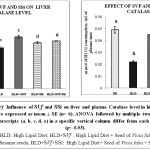 |
Figure 1 Click here to View figure |
In the animals that received HLD significantly (p < 0.05) reduced 55.90% SOD in plasma and 29.85% SOD in liver when compared to ND. In the same way, the group treated with 10% SVf significantly(p <0.05) uplift 114.31% SOD in plasma and 33.47% SOD in liver tissue in respect to HLD. Likewise, 10% SSi treated rats presented elevation in 56.33% SOD in plasma and 14.46% SOD in liver homogenates than the HLD. The treatment with combined supplementation of SVf+SSi (5%+5%) significant increase 99.29% plasma SOD and 26.85% liver SOD when compared to the HLD. From the above result, 10% SVf showed an expressive elevation of SOD level in plasma and liver than the other two supplemented groups (Fig. 2).
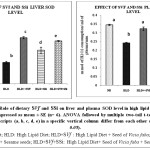 |
Figure 2 Click here to View figure |
It was observed the level of plasma and liver MDA significantly increased 50.49% and 26.40% in HLD than the ND. By the treatment with 10% SVf plasma and liver MDA concentration significantly (p < 0.05) lowered 21.73% and 9.18% respectively in comparison to HLD. Similarly, 10% SSi supplementation significantly (p < 0.05) downgrade the 56.84% MDA in plasma and 29.17% MDA in liver in respect to HLD.The concentration of MDA significantly (p < 0.05) depleted 42.80% in plasma and 21.62% in liver tissue by SVf+SSi than the HLD. The elevated MDA concentration significantly (p < 0.05) countered by 10% SSi supplementation than the other two supplemented groups (Fig. 3).
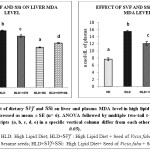 |
Figure 3 Click here to View figure |
Plasma GOT level significantly (p < 0.05)30.86% increased and liver GOT level activity significantly (p < 0.05)38.20% increased in HLD with respect to ND. SVf10% supplementation significantly (p < 0.05) depleted 21.89% in plasma GOT and17.36% depleted in liver GOT than the HLD. It is also observed that 35.34% decrement in plasma GOT level and 29.51% decrement in liver GOT level 10% SSi supplementation along with HLD in comparison to HLD. In supplementation with SVf+SSi (5%+5%) significantly (p < 0.05) 32.21% diminution in plasma GOT and 38.62% diminution in liver GOT with comparison to HLD. Among the three dietary supplementation groups, 10% SSi supplemented group showed highest beneficial effect in plasma GOT level and combined supplementation (SVf+SSi) showed better positive influence in liver GOT level than the other two groups (Fig. 4).
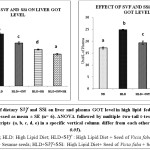 |
Figure 4 Click here to View figure |
It was demonstrated 22.95% elevation of plasma GPT and 26.70% elevation of liver GPT in HLD when compared with ND. In the same way, treated with 10% SVf significantly depleted 9.99% in plasma and 10.61% in liver tissue in respect to HLD. Similarly, 10% SSi fed rats presented depletion in 22.35% GPT in plasma and 22.89% GPT in liver than the HLD. The treatment with combined supplementation of SVf+SSi (5%+5%) significantly decreased 20.48% plasma GPT and 20.38% liver GPT when compared to the HLD. From the above result, 10% SSi showed an expressive depletion of GPT level in plasma and liver than the other two supplemented groups (Fig. 5).
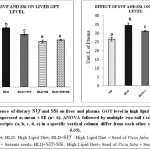 |
Figure 5 Click here to View figure |
In this present study it was observed that HLD fed animals significantly increased 29.51% plasma IL-18 level compared with ND. After supplementation of 10% SVf and 10% SSi the level of IL-18 in plasma significantly 12.76% and 21.60% decreased as compared to HLD. In supplementation with SVf+SSi (5%+5%) significantly (p < 0.05) 29.25% diminution in plasma IL-18 with comparison to HLD. Among the three dietary supplementation groups, combined supplementation (SVf+SSi) showed high positive influence on plasma IL-18 concentration than the other two supplementation groups (Fig. 6).
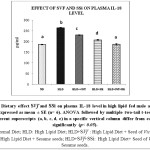 |
Figure 6 Click here to View figure |
The highest decreasing capacity of TG and TC was observed in HLD+SSi group, these values was nearest to the ND group probability due to the presence of lignans, polyphenol, and flavonoid compounds, dietary fibers, PUFA, and lecithin in sesame.37-39 Many of the experimental study confirmed that sesame slowdown the risk of cardiovascular disease.40-42 Another evidence was high fecal cholesterol and high fecal lipid in HLD+SSi group than the other dietary supplemented groups. It has been suggested that TC and other lipids were removed via bile into fecal matter rather than transferred into the circulation indicated the fat-modified diet with HLD+SSi help to remove cholesterol via feces. On the other hand, LDL-C was decreased and HDL-C was increased in 3 supplemented groups when compared to HLD group.The highest positive effect was observed in HLD+SSi group result near to the ND group, test of hypothesis, high amount of polyunsaturated fatty acids (PUFA), monounsaturated fatty acids (MUFA). It was evidenced by increasing the level of fecal TC and decreased plasma TC in 3 dietary supplementary groups.Correlating low level of LDL-C, and HDL-C. Low level of plasma TC down regulates LDL-C receptors in extra-hepatic tissue which is one of the most important reasons to decreasing LDL-C and increasing HDL-C.34
The present study also revealed that, the activity of CAT and SOD were significantly decreased(p<0.05) in HLD group as compared to 3 supplemented groups mainly due to high cholesterol, fat, energy diet while these parameters of in supplementary groups were increased due to low cholesterol and low plasma TG. Otherwise, MDA level in liver tissue in HLD group is high by elevated level of LDL-C, TG, and TC.The study showed that the lipid peroxidation level (MDA) is drastically high in HLD group. After treating with SVf, SSi and its composite manner the level of the MDA is significantly decreased (p<0.05). In which the treatment HLD+SSi showed the good result than the other two treatment groups. SSi and SVf contain high level of omega- 3 fatty acid about 10% more than omega- 6 fatty acid which were analyzed in our laboratory (data were not shown in this paper).The study weakness was the fact that we did not analyze anti-inflamatory and pro-inflamatory markers, despite excellent compliance of over omega-3 and omega-6 fatty acids contents in SVf and SSi. Standard recommendation of ratio omega- 3: omega- 6 is 1:4 indicated to have beneficial effect.Omega- 6 fatty acid like arachidonic acid and pro-inflammatory eicosanoids compound including prostaglandins – 2 (PG- 2), thromboxane (TXA2), leukotrienes (LBT- 4) and lipoxins in cell membrane. These pro-inflammatory eicosanoid increased lipid peroxidation and decreased the antioxidant enzyme level in the cell. Omega -3 fatty acid like eicosapentaenoic acid, docosahexaenoic acid and anti-inflammatory eicosanoids compounds including prostaglandins – 1 (PG- 1),prostaglandins – 3 (PG- 3) thromboxane (TXA2), leukotrienes (LBT- 4) and lipoxins in cell membrane. These anti-inflammatory eicosanoids decreased the lipid peroxidation and increased the antioxidant enzyme level in the cell.43 Evidence suggested that SVf and SSi contains a proportional amount of these fatty acids which might be one of the evidence to decrease lipid profile and lipid peroxidation. Earlier study have shown that there is a prominent relationship between hypercholesterolemia and some liver diseases due to high cholesterol deposits in the liver which can be oxidized by free radicals thereby causing hepatic injury.44
In this study, we observed that there were significant (p<0.05) decrease in plasma and liver levels of GOT and GPT enzymes in HLD+SVf,HLD+SSi,HLD+SVf+SSi groups as compared to HLD fed animals. So, above three dietary supplementation had no general and metabolic toxic effect.This is in agreement with many authors who reported the activities of ALT and AST high in high fat fed rats model which significantly normalization after the treatment with sesame meal and sesame oil.45
HLD group rats fed diet with high cholesterol, high sucrose, coconut oil increases the plasma cholesterol level and which may cause dysregulated cholesterol metabolism in liver. Over burden of plasma cholesterol level activates monocytes and macrophages in artery, therefore monocytes and macrophages secret the IL-18,evidenced by high concentration IL-18 in plasma in HLD group (Fig. 6).46 Significant augmented plasma IL-18 level in supplementation group clearly support the plasma cholesterol reducing the efficiency of SVf and SSi. Netea et al., observed high plasma IL-18 positively correlated with plasma cholesterol level,46 so our finding are strengthen by this report. Another evidence was proved by Bhat et al. increase oxidative stress and increase oxidation of LDL due to IL-18 administration in male mice.47
Histopathological analysis of liver tissue during experimentation
Evaluate the effect of SVf, SSi, and SVf +SSi on liver histology in the dyslipidemic rats, liver tissues were examined under H and E staining. As shown in (Fig.7, Section B) after HLD fed, liver cells became extremely swelled and ballooned with severely disorganized, around the central vein (CV) are the hepatic cell cords as compared with those from the ND fed rats (Fig.7, Section A). Intensive red coloring is the effect of high contents of fat inside hepatic cell, this result is proved by our earlier study where severe disorganization of liver cells and damaged hepatocytes and blood vessels were seen prominently due to the cause of high fat diet.25 After 60 days of treatment of SVf with HLD liver pathological changes were partially improved as demonstrated by the decreased size fat cells in liver tissue and progress in blood vessel (Fig.7, Section C) but also co-administration of SSi with HLD was seen well-organized liver cells like normal CV and normal hepatocytes (NH) (Fig.7, Section D)as well as in ND group rats. This result was also supported by Azab et al., where orally feeding sesame oil showed normal histological structure of liver tissue with organizes hepatocytes.48 In (Fig.7, Section E) there were the normal hepatocytes are seen as well as slightly affected ones with a small disorganization in the combination of SVf+SSi when compared with SSi group rats.
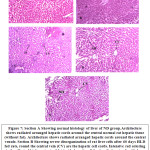 |
Figure 7 Click here to View figure |
Correlation analysis: Lipid peroxidation versus Total Cholesterol
Correlation analysis was also represented graphically by scatter diagram. Plasma MDA values were taken on the vertical axis and plasma TC values were taken on the horizontal axis (Fig.8). There was no significant (p > 0.05) correlation between plasma lipid peroxidation and increase in plasma TC in ND (r = 0.708) and HLD (r = 0.756) groups but high in lipid peroxidation showed high in total plasma TC in both high fat high cholesterol diet (Fig.8, A,B). A weak downhill negative (r = – 0.261) relation showed HLD+SVf supplementation and a very week uphill positive (r = + 0.096) relation showed HLD+SVf+SSi composite supplementation indicating the interfere of LPO by increasing the TC (Fig.8, C,E).There was weak relation between TC and LPO that resulted in the reduction of the level of LDL-Cand higher the level of HDL-C. A strong downhill negative (r = – 0.839) (Fig.8, D) significant (p < 0.05) relation showed between TC and LPO in HLD+SSi supplementation group indicate increased the level of good cholesterol in plasma. A correlation result strongly hypothesized that SSi may play a good antidyslipidemic foods after deep investigation in molecular level in future.
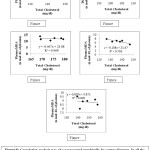 |
Figure 8 Click here to View figure |
Conclusions
High lipid diet induced dyslipidemia in rats (HLD) was proved to be evident by the increasing level of TC, TG, LDL-C, MDA, GOT, GPT, IL-18 and the decreasing level of HDL-C,SOD and CAT level than that of ND group. Only the sesame seeds (SSi) supplementation (10% of total foods) in diet showed significant decrease in TC, TG, LDL-C, MDA and significant increase in HDL-C level as compared to HLD, SVf and SVf+SSi groups. Vicia faba (SVf) supplementation (10% of total foods) in the diet showed significantly increased SOD and Catalase than HLD, SSi and SVf+SSi groups. Combination of supplemented seed of Vicia faba (SVf) (5% of total foods) + sesame seeds (SSi) (5% of total foods) showed decreased the level of IL-18, TC, TG, LDL-C, MDA concentration and increase the level of HDL-C, SOD, Catalase than the HLD group. Combination group showed the better result than the individual supplementation in respect of 5% SVf and 5% SSi (% arise from total food). Fifty percent reduction of seed of Vicia faba and sesame seeds (w/w) combined supplementation results significant prevention of dyslipidemia which was an good synergistic effect. Supplementation quantity in combined treatment was reduced 50 %than individual supplementation. While recovery of dyslipidemia varied 10 to 20% in between individual and combined supplementation. So, finally we concluded that seed of Vicia faba and sesame seeds combined supplementation might be accepted and potential against dyslipidemia and further research in future.
Acknowledgments
The authors are grateful to University Grant Commission (UGC), Government of India for providing fund as Maulana Azad National Fellowship for Minority Students (Student ID : 2017-18/MANF-2017-18-WES-79798, Date – 25.07.2017) to first author for this work and also thanks to UGC, Basic Scientific Research (No.- F.9–193/2011 (BSR), Date – 28.09.2016) for providing infrastructure to institute.
Competing Interest
I declare that there is no conflict of interest regarding the publication of this paper which titled “Supplementation of seed dust of Vicia faba and sesame ameliorates high lipid diet-induced dyslipidemia in rats”.
References
- Boye J, Zare F, Pletch A. Pulse proteins: Processing, characterization, functional properties and applications in food and feed. Food Res Int.2010; 43(2):414–431. DOI: 10.1016/j.foodres.2009.09.003
CrossRef - Tosh S.M, Yada S. Dietary fibres in pulse seeds and fractions: Characterization, functional attributes, and applications. Food Res Int.2010; 43(2): 450–460. DOI : 10.1016/j.foodres.2009.09.005
CrossRef - Parmar N, Virdi A.S, Singh N, Kaur A, Bajaj R, Rana J.C, Nautiyal C.S. Evaluation of physicochemical, textural, mineral and protein characteristics of kidney bean grown at Himalayan region. Food Res Int.2014; 66: 45-57.
CrossRef - Luo J, Cai W, Tong W, Xu B. Phytochemical distribution in hull and cotyledon of adzuki bean (Vigna angularis L.) and mung bean (Vigna radiate L.), and their contribution to antioxidant,anti-inflammatory and anti-diabetic activities. Food Chem.2016;34:32-75. DOI: 10.1016/j.foodchem.2016.01.101
CrossRef - Ofuya Z.M, Akhidue V. The role of pulses in human nutrition: A review. Journal of Apply Science and Environmental Management.2005;9: 99-104.
- Anderson J.W, Smith B.M, Washnock C.S. Cardiovascular and renal benefits of dry bean and soybean intake. Am J ClinNutr.1999;70:464 – 474. https://doi.org/10.1093/ajcn/70.3.464s
CrossRef - Foster-Powell K, Holt S.H.A, Brand-Miller J.C. International table of glycemic index and glycemic load values. Am J ClinNutr.2002;76:5–56.https://doi.org/10.1093/ajcn/76.1.5
CrossRef - Tharanathan R.N, Mahadevamma S. Grain legumes: A boon to human nutrition. Trends Food SciTechnol.2003;14:507–518.https://doi.org/10.1016/j.tifs.2003.07.002
CrossRef - Barrett M.L, Udani J.K. A proprietary alpha-amylase inhibitor from white bean (Phaseolus vulgaris): a review of clinical studies on weight loss and glycemic control. Nutritional Journal. 2011; 10:24 –29.doi: 10.1186/1475-2891-10-24
CrossRef - El Khier M.K.E.S, Ishag K.E.A, Yagoub A.E.A. Chemical composition and oil characteristics of sesame seed cultivars grown in Sudan.Res J Agric Biol Sci.2008;4:761–766.
- Roma R.B, Tabekhia M.M, Williams J.D. Phytate and oxalate contents in sesame seed (Sesamum indicum L.). Nutrition Reports International.1979; 20(1):25–31.
- Alyemeni M.N, Basahy A.Y, Sher H. Physico-chemical analysis and mineral composition of some sesame seeds (Sesamum indicum L.) grown in the Gizan area of Saudi Arabia. J Med Plants Res.2011;5: 270–274.
- Jiang X. In: The Analysis and Study of Fatty Acids in Vegetable Oils. Liaoning Normal University, Dalian; 2008 12.
- Orruno E, Morgan M.R.A. Purification and characterization of the 7S globulin storage protein from sesame (Sesamum indicum L.). Food Chem.2007;100:926–934. DOI: 10.1016/j.foodchem.2005.10.051
CrossRef - Kang M.H, Naito M, Tsujihara N, Osawa T. Sesamolin inhibits lipid peroxidation in rat liver and kidney. Journal of Nutrition.1998; 128: 1018–1022.DOI: 10.1093/jn/128.6.1018
CrossRef - Junpeng Y, Zhang Q, Xin L, Xinsheng W, Bing L, Wenxue Z. Steam explosion technology based for oil extraction from sesame (Sesamum indicum L.) seed. Journal of the Saudi Society of Agricultural Sciences. 2016;104:943-956.
- Clarke S.D. Polyunsaturated fatty acid regulation of gene transcription: a mechanism to improve energy balance and insulin resistance. Br.J. Nutr.2000;83:59–66. DOI:10.1093/jn/131.4.1129
CrossRef - Kang M.H, Naito M, Sakai K, Uchida K, Osawa T. Mode of action of sesame lignans in protecting low-density lipoprotein against oxidative damage in vitro. Life Sciences.1999; 66(2): 161-171.
CrossRef - Lemcke-Norojarvi M, Kamal-Eldin A, Appelqvist L.A, Dimberg L.H, Ohrvall M, Vessby B. Corn and sesame oils increase serum tocopherol concentrations in healthy Swedish women. Journal of Nutrition. 2001;131(4):1195–1201. DOI: 10.1093/jn/131.4.1195
CrossRef - Ide T, Kushiro M, Takahashi Y, Shinohara K, Fukuda N, Sirato-Yasumoto S. Sesamin, a sesame lignan, as a potent serum lipid-lowering food component. JARQ. 2003;37(3):151-158.DOI: 10.6090/jarq.37.151
CrossRef - World Health Organization.The Global Burden of Disease: 2004 Update, World Health Organ: Geneva, 2008;2-5.
- Chen P.R, Chien K.L, Su T.C, Chang C.J, Liu T.L, Cheng H, Tsai C. Dietary sesame reduces serum cholesterol and enhances antioxidant capacity in hypercholesterolemia. Nutrition research.2005; 25: 559–567.
CrossRef - NIH. Guide for the Care and Use of Laboratory Animals.US Department of Health, Education and Welfare, National Institute of Health. 2008; 85-23.
- Olfert E.D, Cross B.M, Mc-William A.A. Guide to Care and Use of Experimental Animals. In Olert E. D. & M.C. William BM (Eds.), Canadian Council on Animal Care 2nd edition. 1993;1-90.
- Mallick S, Mandal S, Roy S, Pradhan S, Mandal S, Maiti R.K, Nandi D.K, Das, K. Effect of phytosterol extract from sesame seed on experimentally Induced hyperlipidemic rats: dose dependent study. IJPBS.2016;7(1B): 370 – 377.
- Folch J, Lees M, Sloane Stanley G.H. A simple method for the isolation and purification of total lipides from animal tissues. J BiolChem.1957; 226:497-509.
- Pradhan S, Mandal S, Roy S, Mandal A, Das K, Nandi, D.K. Attenuation of uremia by orally feeding alpha-lipoic acid on acetaminophen induced uremic rats. Saudi Pharm J. 2013;21:187–92.
CrossRef - Roy S, Pradhan S, Das K, Mandal A, Mandal S, Patra A, Nandi, D.K. Acetaminophen Induced Kidney Failure in Rats: A Dose Response Study. Journal of Biological Sciences.2015; 15 (4):187-193.
CrossRef - Das K, Roy S, Mandal S, Pradhan S, Debnath S, Ghosh D, Nandi D.K. Renal protection by isolated phytocompounds from Terminalia arjuna bark fraction on dehydaration induced uremia, oxidative stress and kidney disease rats. International Journal of Recent Scientific Research.2016;79(10):13787-13795.
- Roy S, Das K, Mandal S, Pradhan S, Patra A, Nandi D.K. Asparagus racemosus roots ameliorates acetaminophen induced hepatotoxicity In rats: an experimental, biochemical and histological study. International Journal of Recent Scientific Research.2014;5(6):1192-1197.
- Zhang C, Bi Y, Jin G, Gan H, Yu L. High and fluctuating glucose levels increase the expression and secretion of interleukin‑18 in mouse peritoneal macrophages. Molecular Medicine Reports.2015;12: 2715-2720. https://doi.org/10.3892/mmr.2015.3753
CrossRef - Mani V. Laboratory Techniques in histology. In: Mukherjee KL (eds). Medical Laboratory Technology, 2nd edn. New Delhi: Tata Mac graw Hill Education Private Limited. 2010; 1007-1053.
- Sokal R.R, Rohle F.J. Introduction to analysis of variance. In: Sokal Rr, Rohle FJ, (eds). Biometry, New York: WH Freeman and Company. 1997; 179-206.
- Macarulla M.T, Medina C, Diego M.A.D, Chavarri M, Zulet M.A.J, Alfredo Martinez J.A, Noel-Suberville C, Higueret P, Portillo P.M. Effects of the whole seed and a protein isolate of faba bean (Vicia faba) on the cholesterol metabolism of hypercholesterolaemic rats. Br J Nutr.2001;85:607- 614.
CrossRef - Ratnawati H, Widowati W. Anticholesterol Activity of Velvet Bean (Mucuna pruriens L.) towards Hypercholesterolemic Rats. Sains Malaysiana.2011; 40(4):317–321.
- Matos S.L, Paula H.D, Pedrosa M.L, Santos R.C.D, Oliveira E.L.D, Chianca Júnior D.A, Silva M.E. Dietary Models for Inducing Hypercholesterolemia in Rats. Brazilian archives of biology and technology. 2005; 48(2 ): 203-209.
CrossRef - Visavadiya N.P, Narasimh acharya A.V. Sesame as a hypocholesteraemic and antioxidant dietary component. Food and Chemical Toxicology. 2008; 46(6):1889–1895. DOI: 10.1016/j.fct.2008.01.012
CrossRef - Chen C.Y, Holbrook M, Duess M.A, Dohadwala M.M, Hamburg N.M, Asztalos B.F. Effect of almond consumption on vascular function in patients with coronary artery disease: a randomized, controlled, cross-over trial. Nutr J. 2015; 14: 61.
CrossRef - Moazzami A.A, Kamal-Eldin A. Sesame Seed Is a Rich Source of Dietary Lignans. Journal of the American Oil Chemists’ Society.2006;83(8).
CrossRef - Zhang C, Yu Y, Deng J, Zhang C, Zhang J, Cheng Y, Luo X, Han B, Yang H. Sesamin Ameliorates High-Fat Diet–Induced Dyslipidemia and Kidney Injury by Reducing Oxidative Stress. Nutrients.2016; 8(5): 276. doi: 10.3390/nu8050276.
CrossRef - Saleem M.T.S, Chetty M.C, Kavimani S. Antioxidants and tumor necrosis factor alpha-inhibiting activity of sesame oil against doxorubicin-induced cardiotoxicity. Ther Adv Cardiovasc Dis.2014; 8(1):4–11. DOI: 10.1177/1753944713516532
CrossRef - Korou L.M, Agrogiannis G, Koros C, Kitraki E, Vlachos I.S, Tzanetakou I, Karatzas T, Pergialiotis V, Dimitroulis D, Perrea D.N. Impact of N-acetylcysteine and sesame oil on lipid metabolism andhypothalamic-pituitary-adrenal axis homeostasis in middle-aged hypercholesterolemic mice. Scientific reports. 2014;4 : 6806. DOI: 10.1038/srep06806
CrossRef - Pirillo A, Catapano A.L. Omega-3 polyunsaturated fatty acids in the treatment of atherogenic dyslipidemia. atherosclerosis supplements.2013;14(2):237-242.
CrossRef - Rao V, Kiran R. Evaluation of correlation between oxidative stress and abnormal lipid profile in coronary artery disease. J Cardiovasc Dis Res. 2011;2 (1): 57-60. doi: 10.4103/0975-3583.78598
CrossRef - Uthandi A., Ramasamy K. Hepatoprotective activity of sesame meal on high fat fed wistar rats. Inter J Pharm Sci and Res.2011;2(12):205-211.
- Netea M.G, Kullberg B.J, Verschueren I, Van Der Meer J.W. Interleukin-18 induces production of proinflammatory cytokines in mice: no intermediate role for the cytokines of the tumor necrosis factor family and interleukin- 1beta. Eur J Immunol.2000; 30:3057–60.
CrossRef - Bhat O.M, Kumar P.U, Giridharan N.V, Kaul D, Kumar M.J, Dhawan V. Interleukin-18-induced atherosclerosis involves CD36 and NF-kB crosstalk in Apo E_/_ mice. Journal of Cardiology. 2015;66:28–35.
CrossRef - Azab A.E.S. Hepatoprotective effect of sesame oil against lead induced liver damage in albino mice: Histological and biochemical studies. American Journal of Bio Science. 2014;2(2): 1-11. doi: 10.11648/j.ajbio.s.20140202.11

This work is licensed under a Creative Commons Attribution 4.0 International License.







